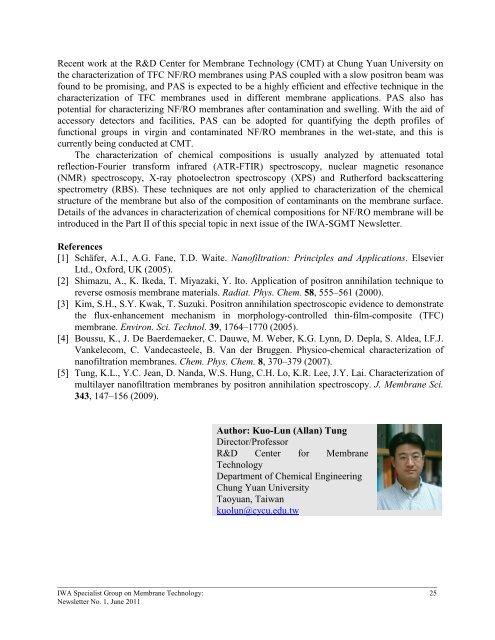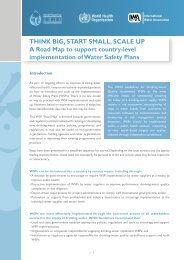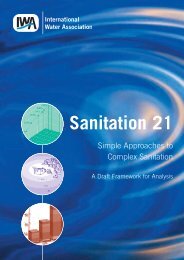Specialist Group on Membrane Technology - IWA
Specialist Group on Membrane Technology - IWA
Specialist Group on Membrane Technology - IWA
You also want an ePaper? Increase the reach of your titles
YUMPU automatically turns print PDFs into web optimized ePapers that Google loves.
Recent work at the R&D Center for <strong>Membrane</strong> <strong>Technology</strong> (CMT) at Chung Yuan University <strong>on</strong>the characterizati<strong>on</strong> of TFC NF/RO membranes using PAS coupled with a slow positr<strong>on</strong> beam wasfound to be promising, and PAS is expected to be a highly efficient and effective technique in thecharacterizati<strong>on</strong> of TFC membranes used in different membrane applicati<strong>on</strong>s. PAS also haspotential for characterizing NF/RO membranes after c<strong>on</strong>taminati<strong>on</strong> and swelling. With the aid ofaccessory detectors and facilities, PAS can be adopted for quantifying the depth profiles offuncti<strong>on</strong>al groups in virgin and c<strong>on</strong>taminated NF/RO membranes in the wet-state, and this iscurrently being c<strong>on</strong>ducted at CMT.The characterizati<strong>on</strong> of chemical compositi<strong>on</strong>s is usually analyzed by attenuated totalreflecti<strong>on</strong>-Fourier transform infrared (ATR-FTIR) spectroscopy, nuclear magnetic res<strong>on</strong>ance(NMR) spectroscopy, X-ray photoelectr<strong>on</strong> spectroscopy (XPS) and Rutherford backscatteringspectrometry (RBS). These techniques are not <strong>on</strong>ly applied to characterizati<strong>on</strong> of the chemicalstructure of the membrane but also of the compositi<strong>on</strong> of c<strong>on</strong>taminants <strong>on</strong> the membrane surface.Details of the advances in characterizati<strong>on</strong> of chemical compositi<strong>on</strong>s for NF/RO membrane will beintroduced in the Part II of this special topic in next issue of the <strong>IWA</strong>-SGMT Newsletter.References[1] Schäfer, A.I., A.G. Fane, T.D. Waite. Nanofiltrati<strong>on</strong>: Principles and Applicati<strong>on</strong>s. ElsevierLtd., Oxford, UK (2005).[2] Shimazu, A., K. Ikeda, T. Miyazaki, Y. Ito. Applicati<strong>on</strong> of positr<strong>on</strong> annihilati<strong>on</strong> technique toreverse osmosis membrane materials. Radiat. Phys. Chem. 58, 555–561 (2000).[3] Kim, S.H., S.Y. Kwak, T. Suzuki. Positr<strong>on</strong> annihilati<strong>on</strong> spectroscopic evidence to dem<strong>on</strong>stratethe flux-enhancement mechanism in morphology-c<strong>on</strong>trolled thin-film-composite (TFC)membrane. Envir<strong>on</strong>. Sci. Technol. 39, 1764–1770 (2005).[4] Boussu, K., J. De Baerdemaeker, C. Dauwe, M. Weber, K.G. Lynn, D. Depla, S. Aldea, I.F.J.Vankelecom, C. Vandecasteele, B. Van der Bruggen. Physico-chemical characterizati<strong>on</strong> ofnanofiltrati<strong>on</strong> membranes. Chem. Phys. Chem. 8, 370–379 (2007).[5] Tung, K.L., Y.C. Jean, D. Nanda, W.S. Hung, C.H. Lo, K.R. Lee, J.Y. Lai. Characterizati<strong>on</strong> ofmultilayer nanofiltrati<strong>on</strong> membranes by positr<strong>on</strong> annihilati<strong>on</strong> spectroscopy. J. <strong>Membrane</strong> Sci.343, 147–156 (2009).Author: Kuo-Lun (Allan) TungDirector/ProfessorR&D Center for <strong>Membrane</strong><strong>Technology</strong>Department of Chemical EngineeringChung Yuan UniversityTaoyuan, Taiwankuolun@cycu.edu.tw_______________________________________________________________________________________________________<strong>IWA</strong> <str<strong>on</strong>g>Specialist</str<strong>on</strong>g> <str<strong>on</strong>g>Group</str<strong>on</strong>g> <strong>on</strong> <strong>Membrane</strong> <strong>Technology</strong>: 25Newsletter No. 1, June 2011
















